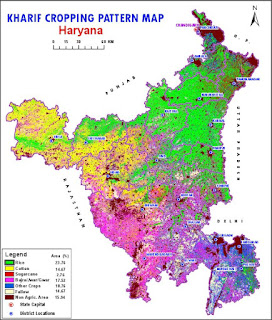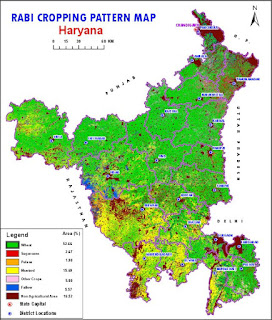The gross area sown in the State during 2018-19 is likely to have been 64.90 lakh hectare. The food-grains production in the State has reached an impressive level of 184.20 lakh tonne during the year
2019-20. The contribution of area under wheat and paddy crops to the total gross area sown in the State was 61.63% during 2018-19.
- The area under Paddy crop was 25.34 lakh hectare in 2019-20 and The production of rice was 51.98 lakh tonne in 2019-20.
- Similarly, the production of wheat was 118.77 lakh tonne in 2019-20.
- The production of oilseeds and sugarcane during 2019-20 was 11.75 lakh tonne and 77.30 lakh tonne, respectively.
- The production of Cotton was estimated 24.85 lakh bales in 2019-20.
- Haryana is a major contributor of food-grains to the Central Pool. More than 60% export of Basmati Rice is taking place from the State
OPERATIONAL HOLDINGS in Haryana (Agri. Census 2015-16)-
| (a) | No. of Operational Holdings | Thousand Number | 1,628 |
| (b) | Area of Operational Holdings | Thousand Hect. | 3,609 |
| (c) | Average Size of Holdings | Hect. | 2.22 |
Average Size of Holdings in Haryana is 2.22hect. while 1.08 in India
LAND UTILIZATION in Haryana(2018-19)-
| (a) | Net Area Sown | Thousand Hect. | 3,601 |
| (b) | Area Sown More than Once | Thousand Hect. | 3,004 |
| (c) | Total Cropped Area | Thousand Hect. | 6,605 |
| (d) | Area Sown More than Once to Net Area Sown | Percent | 83.42 |
Mainly, there are 2 cropping seasons in a year-
1. Kharif Crops- Kharif pulse crops require warm climate throughout their life from sowing to harvesting.
Kharif crops includes paddy, jowar, bajra, maize, ragi, tur (arhar), moong, urad, groundnut, soybean (yellow), sunflower seed, sesamum, nigerseed, cotton, sugarcane
Rice/Paddy-
Rice crop needs a hot and humid climate. It is best suited to regions which have high humidity, prolonged sunshine and an assured supply of water.
The average temperature required throughout the life period of the crop ranges from 21 to 37º C.
2.Rabi Crops- Rabi crops require mild cold climate during sowing period, during vegetative to pod development cold climate and during maturity / harvesting warm climate.
Rabi crops includes wheat, barley(jau), gram, masur (lentil), rapeseed/mustard, safflower and two commercial crops viz. jute and copra.
- The best wheat are produced in areas favoured with cool, moist weather during the major portion of the growing period followed by dry, warm weather to enable the grain to ripen properly.
- The optimum temperature range for ideal germination of wheat seed is 20-25 C.
- Soils with a clay loam or loam texture, good structure and moderate water holding capacity are ideal for wheat cultivation
Pulses-
Pulses are consumed as Dal, which is a cheap source of plant protein.
Some pulse crops like Gram, Lobia, Urdbean & Moongbean are fed to animals as green fodder.


Comments
Post a Comment